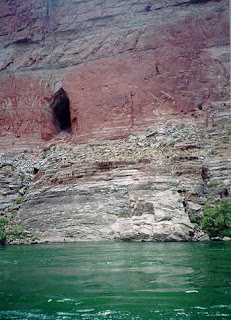Is there, within the Grand Canyon, an enigmatic system of tunnels that is evidence of an ancient Egyptian voyage to America? Is it all bogus? Or is the truth most likely somewhere in between?
On April 5, 1909, a front page story in the Arizona Gazette reported on an archaeological expedition in the heart of the Grand Canyon funded by the Smithsonian Institute, which had resulted in the discovery of Egyptian artefacts. April 5 is close to April 1 – but then not quite… so perhaps the story could be true?
Nothing since has been heard of this discovery. Today, over five million tourists visit the Grand Canyon each year. You would thus expect that if anything was hidden in the canyons, it would thus since long have been uncovered. However, most tourists only spend around 3 hours of time at the canyon, usually visiting the legendary South Rim view around mile 89, where most of the best and oldest tourist facilities are located. Furthermore, some have said that the entire discovery has since become the centre of a major cover-up, apparently in an effort to maintain the old status quo, which is that the ancient Egyptians never ventured outside of the tranquil waters of the river Nile.
The original story goes that the team found an underground network of tunnels, high above the Colorado River, containing various ancient artefacts, statues and even mummies. A major discovery, no doubt about it. Impossible to slip off the archaeological radar. Still, the Smithsonian Institute will report it has no records on the subject. So what happened? To find out, there is only one guide: the article itself. Though the article was anonymous, it did identify some of the archaeologists involved: “under the direction of Prof. S. A. Jordan”, with Smithsonian-backed adventurer G. E. Kinkaid, who then relates his findings.
But the story gets weirder when the Smithsonian stated that it had no Kinkaid or Jordan on record. In one enquiry from 2000, the institution replied: “The Smithsonian Institution has received many questions about an article in the April 5, 1909 Phoenix Gazette about G. E. Kincaid and his discovery of a ‘great underground citadel’ in the Grand Canyon, hewn by an ancient race ‘of oriental origin, possibly from Egypt.’ […] The Smithsonian’s Department of Anthropology, has searched its files without finding any mention of a Professor Jordan, Kincaid, or a lost Egyptian civilization in Arizona. Nevertheless, the story continues to be repeated in books and articles.” There is room for a cover-up, of course, as some have argued. The files do not necessarily have to set within that department’s and the reference to the Phoenix Gazette rather than Arizona Gazette could be a simple error, or an escape valve that is so often present in official replies engineered to debunk. Stories like “the CIA Division X has no record” often means that Division Y is the one who has that record.
So, there is no Professor Jordan, and Kinkaid himself was more than difficult to pin down. However, on March 12 of the same year, the Gazette had reported on an earlier phase of Kincaid’s adventure: “G. E. Kincaid Reaches Yuma.” Here, Kinkaid is identified as being from “Lewiston, Idaho”; he “arrived in Yuma after a trip from Green River, Wyoming, down the entire course of the Colorado River. He is the second man to make this journey and came alone in a small skiff, stopping at his pleasure to investigate the surrounding country. He left Green River in October having a small covered boat with oars, and carrying a fine camera, with which he secured over 700 views of the river and canyons which were unsurpassed. Mr. Kincaid says one of the most interesting features of the trip was passing through the sluiceways at Laguna dam. He made this perilous passage with only the loss of an oar.” The account is factual enough and seems to just that: fact. The article concludes: “Some interesting archaeological discoveries were unearthed and altogether the trip was of such interest that he will repeat it next winter in the company of friends.” Less than a month later, the same newspaper seemed to continue their story where they had left it off: Kinkaid was now talking about his “interesting archaeological discoveries”, which consisted out of a series of tunnels and passages with a cross chamber near the entrance, containing a statue: “The idol almost resembles Buddha, though the scientists are not certain as to what religious worship it represents. Taking into consideration everything found thus far, it is possible that this worship most resembles the ancient people of Tibet.” He also stated that he had found an unknown gray metal, resembling platinum, as well as tiny carved heads, scattered on the floor. Urns bore “mysterious hieroglyphics, the key to which the Smithsonian Institute hopes yet to discover.” In another room he found mummies: “Some of the mummies are covered with clay, and all are wrapped in a bark fabric.”



Be the first to comment on "Evidence of ancient Egypt in the Grand Canyon?"